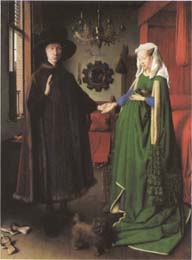|
|
比較文法(ドイツ語と英語)
|
|
|
 |
|
|

|
|
|
 |
|
|
人称代名詞の格変化:
|
Nhd
|
Mod.E.
|
|
主格
|
ich |
I |
|
属格
|
meiner |
of me |
|
与格
|
mir |
to me |
|
対格
|
mich |
me |
|
注:ドイツ語の mein (所有代名詞) は、英語の my (所有格)に対応する。
英語の人称代名詞も古くは格変化をした (ic, min, me, mec)。
近代英語では人称代名詞の属格が消滅、多くは前置詞 of によって表わされるようになる。
人称代名詞の2格は「名詞的」なもの、所有代名詞は「形容詞的」なものと捉えることもできる。
|
cf.
|
statt meiner |
(instead of me) |
|
statt meines Vaters |
(instead of my father)
|
|
なお、サンプルをもう少し:
|
| Sie dankte mir statt Ihrer. |
(She thanked me instead of you.)
|
Wir bedürfen euer nicht.
|
(We have no need of you. We don't need you.)
|
| Ich klopfte auf seine Schulter. |
(I patted on his shoulder.)
|
|
その他のいくつかの特徴:
1)ドイツ語では事物を受ける場合でも、3人称単数の人称代名詞はそれぞれ性を一致させ、英語のように it をもって受けない。
|
Hier ist ein Tisch. Er ist groß.
|
(Here is a desk. It is large.)
|
|
2)身体の部分や持ち物を示す名詞について:
ドイツ語では定冠詞。Mod.E.では一般に所有代名詞を用いる。
|
Er steckte den Bleistift in die Tasche.
|
(He put his pencil in his pocket.)
|
|
そしてこのような場合、ドイツ語ではよく所有の3格も用いられる。
|
Ich wasche mir die Hände.
|
(I wash my hands.)
|
|
前の例も
Ich klopfte ihm auf die Schulter. の表現の方が好まれる。
英語にも、I patted him on the sholder. や She looked me in the face. などの表現が見られるけれども、慣用的用法に限定されている。
3)独立させて使う場合
|
Dieser Bleistift ist mein. : 所有代名詞
|
(The pencil is mine.) : 名詞的所有代名詞
|
|
4)It's me. 私です。(It's I. は文語): この用法は、フランス語の C'est moi. の影響なのかどうか、はっきりしたことはわからない。ともかく I は、「動詞を伴う主格の場合」に限定されているようだ。
ドイツ語の方は: Das bin ich. / Ich bin es.
|
|
|

|
|
 |
|
|
ドイツ語における形容詞は、付加語的用法の場合、3種類の変化(強変化、弱変化、混合変化)に分類される(変化表は省略)。
英語の形容詞も古くは変化したが、15世紀には消失した。
→ そのため名詞、副詞なども形容詞として用いることが可能になった。
これは Mod.E の一大特徴である。
| ex. |
the bath-room door, a gold watch, the then owner of the house, etc.
|
|
述語的形容詞の位置:
形容詞が述語的に用いられる場合、補足語を必要とするものがあるが、
ドイツ語の形容詞は、この場合、概して補足語の後。
英語では、一部を除いて、補足語の前である。
|
| Ich bin dieser Arbeit müde. |
(I am tired of this work.)
|
Er war mit seiner Stellung zufrieden.
|
(He was satisfied with his position.)
|
|
この配列は不定形の語順から捕らえると、理解しやすい:
つまり、以下の sein ないし be が所定の位置で定まった(定形になった)ということ。
|
ドイツ語の不定形:
|
dieser Arbeit müde sein |
|
英語の不定詞句:
|
(be tired of this work.)
|
|
英語において、形容詞を伴うとき、名詞の反復を避けるために用いられる one は、
ドイツ語では形容詞が変化語尾をもつため、必要としない。
なお、英語の one が用いられるようになったのは14世紀頃から。
|
Ich bin Künstler, wenn auch ein erbärmlicher.
|
(I am an artist, though a poor one.)
|
|
|
|
|
 冠飾句 冠飾句
ドイツ語では、付加語的形容詞が副詞や補足語を伴うときも、
長い冠飾句をなして名詞の前に置くことができる。
英語では、形容詞が無変化ゆえ
このような配置をしようとすれば意味が不鮮明になるためか、
この用法はなく、長い形容句は名詞の後に置く。
| Das ist ein in Rußland sehr gewöhnliches Tier. |
| (That is an animal very common in Russia.) |
| Er grüßte sie mit der ihm eigenen Höflichkeit. |
| (He greeted her with politeness peculiar to him.) |
|
上のドイツ語は、「不定冠詞+形容詞句+中性名詞」および「定冠詞+形容詞句+女性名詞(与格)」のパターン
|
|
 Jan van Eyck
Jan van Eyck
Double Portrait of Giovanni: Arnolfini
and His Wife
National Gallery, London
|
|
|

|
|
|
国名、地名から作られた固有形容詞は、ドイツ語では小文字、英語では大文字。
|
amerikanisch , englisch , deutsch .
|
(American, English, German.)
|
|
 形容詞の名詞的用法 形容詞の名詞的用法
形容詞が性、数を表わす語尾変化をした古い英語では、ドイツ語と同じように形容詞の名詞化も盛んに行われたが、
今日では、the + 形容詞 は人の全体を意味するか、
(the poor = poor people, the rich = rich people)
あるいはドイツ語の中性の意味を持つ。
(the true = truth, the beautiful = beauty)
現実の個人・物を意味するときは、
person, man, woman, people, thing, one などを加えなければならない。
|
| der Gute, die Gute |
(the good man, the good woman)
|
Ein Blinder und ein Lahmer helfen gegeneinander.
|
(A blind man and a lame one help each other.)
|
|
|
|
|
|
|
|
|
|
|
|
 |
|
|
|
|
|
|
|